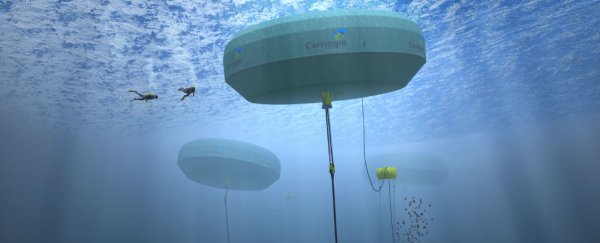The world's first grid-connected wave power station has been activated off the coast of Western Australia (WA).
After more than a decade of testing and demonstrations, Australian company Carnegie Wave Energy has switched on a pilot project that has begun feeding wave-generated electricity into a local WA grid.
"This is the first array of wave power generators to be connected to an electricity grid in Australia and worldwide," said Ivor Frischknecht, CEO of the Australian Renewable Energy Agency, in a statement. The Agency has provided $13 million of the $32 million project.
The company's technology named CETO after a Greek goddess of the sea converts ocean swell into zero-emission renewable power and zero-emission desalinated freshwater.
The company says its system is "different from other wave energy devices as it operates under water where it is safer from large storms [and corrosion] and invisible from the shore".
The round, submerged buoys are tethered to seabed pump units, which are installed at a depth of between 25 and 50 metres. Waves crashing into the buoys drive the pumps, which push pressurised seawater through a pipeline beneath the ocean floor to an onshore hydroelectric power station. Here, the high-pressure water drives a turbine and generates electricity.
"The high-pressure water can also be used to supply a reverse osmosis desalination plant, replacing or reducing reliance on greenhouse gas-emitting, electrically-driven pumps usually required for such plants," the company states on its website.
As Sophie Vorath reports for RenewEconomy, the "project will sell power to the Australian Department of Defence to supply Australia's largest naval base, HMAS Stirling, which is located on Garden Island. It will soon also sell fresh water to the base, once Carnegie's newly commissioned desalination plant is fully integrated into the project".
So far, only two of the project's three buoys have been installed. You can watch the sped-up installation of the second buoy, though be forewarned, the accompanying music might make you dizzy.
"During the testing phase, the first 240kW peak capacity CETO 5 wave unit operated successfully for more than 2,000 hours," Frischknecht said in a statement.
The company's larger CETO 6 units, which are already being developed, are expected to have four times the power generating capacity.
 Diagram of the CETO 5 and the CETO 6 systems (Credit: Carnegie Wave Energy)
Diagram of the CETO 5 and the CETO 6 systems (Credit: Carnegie Wave Energy)
Carnegie chief executive Michael Ottaviano told The West Australian the project could pave the way for much bigger versions capable of powering towns.
"The challenge from here on is really about scale and cost," he said. "We need to make the technology bigger, we need to make our projects bigger because that's what allows you to get your costs down."
"Our wave resources in Western Australia are the best in the world, and theoretically, the resources that hit our coastline everyday could power the state 10 times over," Ottaviano told ABC News.
Check out the ABC News report below
Sources: RenewEconomy, ABC News, The West Australian
